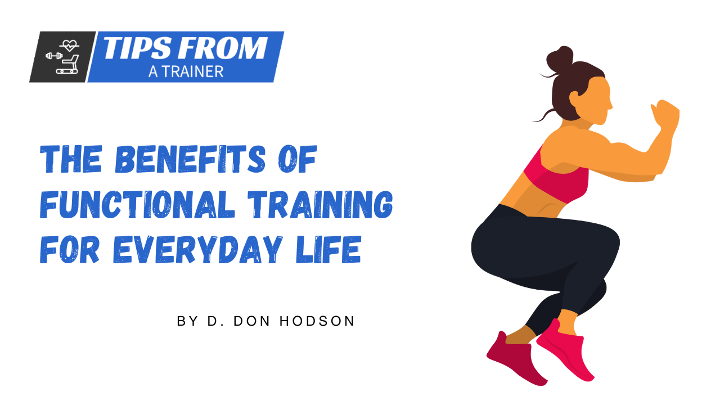Introduction
Functional training is a fitness approach that focuses on enhancing movement patterns and overall functionality. Unlike traditional training methods that isolate specific muscles, functional training aims to improve the body's ability to perform real-life activities with ease and efficiency. By engaging multiple muscle groups and emphasizing natural movement patterns, functional training prepares the body for the demands of everyday life.
To understand functional training better, let's delve into its key aspects and principles. Functional training revolves around the concept of movement patterns rather than individual muscles. Instead of isolating muscles in exercises like bicep curls or leg extensions, functional training integrates various muscle groups to mimic movements performed in daily activities or sports.
Table of Contents
Introduction
Understanding Functional Training
Enhancing Overall Strength and Stability
Improving Everyday Movement Patterns
Injury Prevention and Rehabilitation
Enhancing Athletic Performance
Integrating Functional Training into Your Routine
Assess Your Goals
Seek Professional Guidance
Progress Gradually
Focus on Form and Technique
Incorporate Variety
Combine Functional and Traditional Training
Conclusion

Understanding Functional Training
The exercises in functional training are designed to improve strength, stability, balance, coordination, and flexibility simultaneously. By targeting multiple aspects of fitness, functional training enhances overall physical performance and reduces the risk of injuries. It also promotes efficient movement patterns, which can have a positive impact on posture and joint health.
Functional training often incorporates exercises that engage the core muscles, as they play a crucial role in maintaining stability and transferring force between the upper and lower body. Core exercises such as planks, wood chops, and Russian twists are commonly included in functional training routines.
Enhancing Overall Strength and Stability
One of the primary benefits of functional training is its ability to enhance overall strength and stability. Traditional weightlifting exercises may develop isolated muscle strength, but functional training takes it a step further by improving strength in movement patterns that we encounter in our daily lives.
Functional training focuses on compound exercises, which involve multiple joints and muscle groups working together. These exercises simulate real-life movements and demand the activation of various muscle groups simultaneously. Examples of compound exercises include squats, lunges, deadlifts, push-ups, and pull-ups.
By engaging multiple muscles and joints, functional training helps develop functional strength that translates to improved performance in everyday activities. The emphasis on stability and balance further enhances the body's ability to maintain control and prevent falls or injuries during dynamic movements.
Functional training also places a significant emphasis on strengthening the core muscles. The core plays a vital role in stabilizing the spine, maintaining proper posture, and transferring force between the upper and lower body. Strengthening the core through functional exercises like planks, bird dogs, and mountain climbers not only improves stability but also supports overall movement efficiency.
Improving Everyday Movement Patterns
Functional training is highly effective in improving movement patterns that we perform in our daily lives. Whether it's walking, bending, lifting, or carrying objects, functional training exercises target the muscles and movement patterns involved in these activities.
By incorporating functional exercises into your routine, you can enhance movement efficiency and coordination. Functional exercises often involve multi-directional movements and challenge the body to move in different planes of motion. This helps improve coordination and agility, allowing you to navigate various situations with ease.
Functional training goes beyond isolated muscle strengthening and focuses on movements that involve multiple muscle groups working together. For example, exercises like squats and lunges mimic the movement patterns used when getting up from a chair or climbing stairs. By training these movements, functional training helps you perform these activities more efficiently and with reduced effort.
This aspect of functional training is particularly beneficial for older adults, as it helps them maintain independence and mobility. By improving movement patterns and functional strength, older individuals can perform daily tasks with greater ease, reducing the risk of falls and improving overall quality of life.
Injury Prevention and Rehabilitation
Functional training plays a crucial role in injury prevention and rehabilitation. It helps address muscular imbalances and weak areas that can lead to injuries, providing a holistic approach to fitness and wellness.
Many injuries occur due to muscular imbalances, where certain muscles are overdeveloped while others remain weak and underutilized. Functional training aims to correct these imbalances by focusing on exercises that target both the primary muscles and their supporting muscle groups. This balanced approach helps develop overall muscular strength and stability, reducing the risk of injuries caused by muscle imbalances.
Moreover, functional training incorporates "pre-habilitation" exercises, which are exercises performed to prevent injuries before they occur. These exercises focus on strengthening muscles and improving stability in areas prone to injury, such as the knees, shoulders, and lower back. By proactively addressing weak areas, functional training helps minimize the risk of future injuries.
In the realm of rehabilitation, functional training offers a comprehensive approach to regain strength and mobility after an injury or surgery. The emphasis on movement patterns and functional exercises helps individuals reestablish neuromuscular connections and rebuild functional strength in a way that translates to everyday activities.
Functional training can be tailored to specific rehabilitation needs, ensuring that individuals regain their physical abilities and resume their daily routines safely. It provides a gradual progression from basic movements to more complex tasks, facilitating a smooth recovery process.
Enhancing Athletic Performance
In addition to its benefits for everyday life, functional training is highly effective in enhancing athletic performance. Athletes from various sports can benefit from incorporating functional training into their training routines.
Functional training focuses on movements that mimic the demands of specific sports or activities. By training movements rather than isolated muscles, athletes can improve their performance in a sport-specific context. Functional exercises can replicate the movements involved in running, jumping, throwing, and changing directions, helping athletes develop the strength, power, and agility necessary for their respective sports.
For example, a basketball player can benefit from functional exercises that involve lateral movements, explosive jumps, and quick changes of direction. These exercises can improve their agility, coordination, and vertical leap, translating to improved on-court performance.
Functional training also enhances athletic performance by improving movement efficiency and reducing energy leaks. By developing stronger movement patterns and optimizing biomechanics, athletes can maximize their power output and perform with greater efficiency, resulting in improved speed, endurance, and overall performance.
Moreover, functional training helps athletes develop core stability, which is crucial for maintaining balance, generating power, and transferring force throughout the body. A strong core allows athletes to generate more power in their movements and maintain optimal body control during dynamic actions.
Integrating Functional Training into Your Routine
Now that we've explored the various benefits of functional training, it's important to understand how to integrate it into your fitness routine effectively. Here are some key considerations for incorporating functional training into your workouts:
Assess Your Goals
Determine your specific goals, whether they are related to improved everyday functionality, athletic performance, injury prevention, or overall fitness. Understanding your objectives will help you tailor your functional training program to suit your needs.
Seek Professional Guidance
If you're new to functional training or unsure about specific exercises, it's advisable to work with a certified personal trainer or fitness professional. They can assess your movement patterns, design a customized program, and guide you through proper exercise execution to maximize effectiveness and minimize the risk of injury.
Progress Gradually
Functional training often involves complex movements and challenges multiple muscle groups simultaneously. It's crucial to start with exercises suitable for your fitness level and gradually progress as your strength, stability, and coordination improve. This approach allows for a safe and effective adaptation to functional training.
Focus on Form and Technique
Proper form and technique are essential in functional training to maximize its benefits and minimize the risk of injury. Pay attention to proper body alignment, engage the appropriate muscles, and maintain control throughout the entire range of motion. Quality of movement should always take precedence over quantity.
Incorporate Variety
To keep your workouts engaging and prevent plateaus, incorporate a variety of functional exercises that target different movement patterns and muscle groups. This variety will challenge your body in different ways, promoting continuous growth and improvement.
Combine Functional and Traditional Training
While functional training offers numerous benefits, it can be complemented with elements of traditional resistance training, cardiovascular exercise, and flexibility work. Balancing different training modalities can provide a well-rounded fitness program that addresses all aspects of physical fitness.
Conclusion
Functional training is a powerful approach to fitness that offers a wide range of benefits for individuals of all fitness levels, from beginners to athletes. By focusing on movement patterns, engaging multiple muscle groups, and emphasizing functional strength, stability, and coordination, functional training enhances everyday functionality, athletic performance, injury prevention, and overall fitness.
Whether your goal is to move more efficiently, improve your sports performance, reduce the risk of injuries, or enhance your overall physical well-being, integrating functional training into your fitness routine can yield significant results.
Remember, functional training is not just about looking strong; it's about moving better and feeling better in your everyday life. So, embrace functional training, challenge your body with functional movements, and enjoy the benefits of improved functionality, performance, and overall health.

Don Hodson, Certified Personal Trainer
I'm Don, an ACE-certified personal trainer and the founder of Tips From A Trainer. With my passion for fitness and years of experience, I've helped countless individuals transform their physiques!
Having personally overcome weight challenges throughout my life, I understand the struggle. Through consistency, exercise, and a balanced diet, I have managed to stay in shape and I want to share my message with the world!
The fitness industry is fraught with misconceptions and deceptive practices, which is why I am committed to providing you with the truth.
- My Site: www.Don-Hodson.com
- My Company: www.ConnectedAgeMarketing.com

The Benefits of Functional Training for Everyday Life